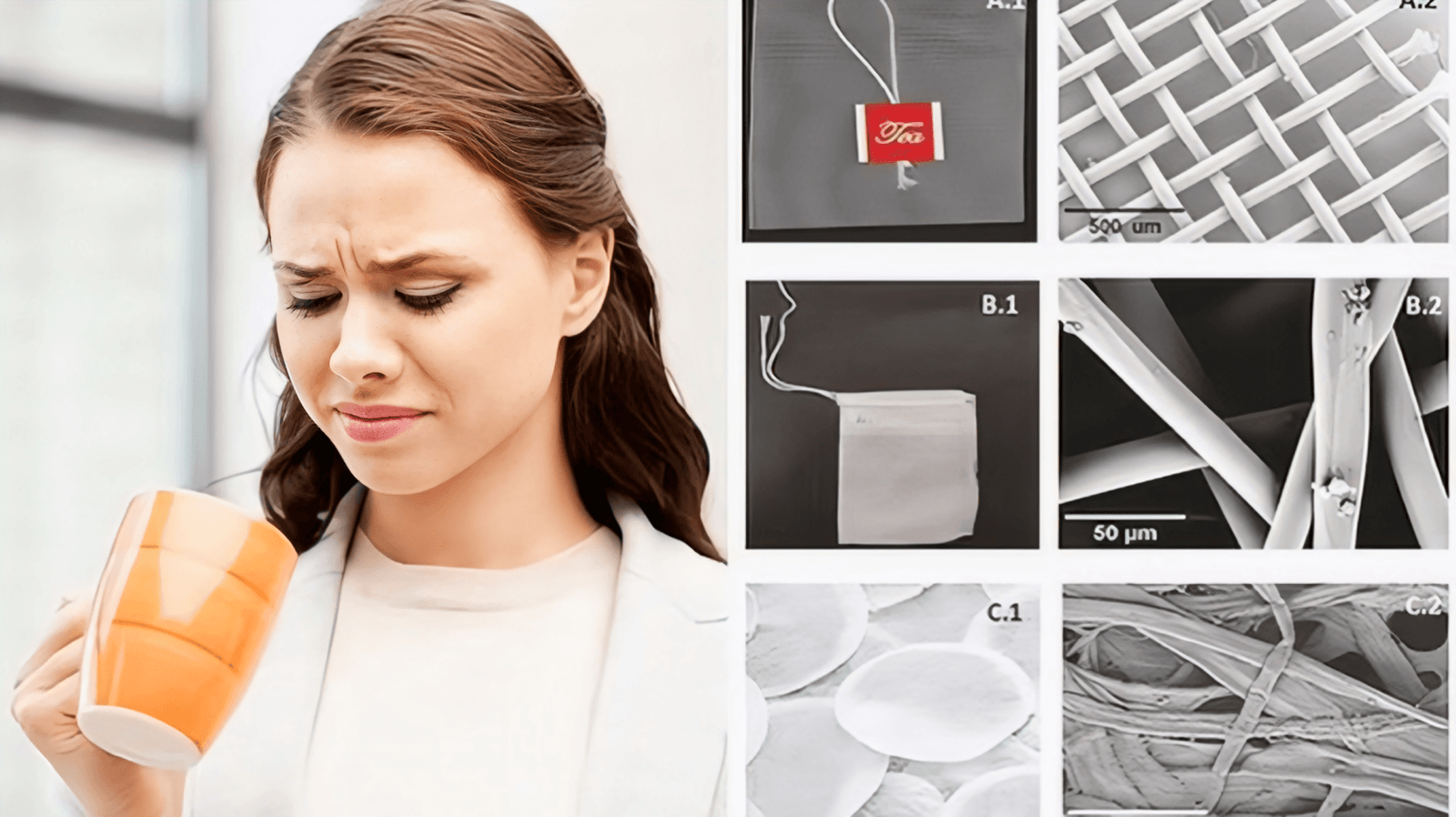Tea bags have long been the epitome of convenience for tea enthusiasts, providing an easy and quick way to warm up with a nice cup of tea.
However, the materials used in producing tea bags and the processes that are used to manufacture them have been criticized to be risky for human health and the environment.
This article uncovers the hidden dangers of tea bags, focusing on plastics, adhesives, and chemicals in them, and presents safer and more sustainable alternatives for tea lovers.
What are Tea Bags Made Of?
Tea bags look simple, but their composition involves a range of materials designed to ensure durability and functionality.
Traditionally, tea bags were made from paper, but modern versions often include plastic or synthetic fibers. Some brands use fully plastic mesh bags, while others use a blend of paper and heat-sealable plastic.
These plastics, such as polypropylene, maintain the form of the tea bag when soaked in hot water. More significantly, adhesives and glues are employed to stick the edges of the bag together, while bleaching agents to make it appear clean and white.
Even though this makes the tea bags convenient and aesthetically pleasing, associated risks are often overlooked.
Microplastics in Your Tea
The most alarming discovery made about tea bags is that they are releasing microplastics into the tea. Microplastics are small plastic pieces, typically smaller than 5 millimeters, which result from the breakage of larger plastic items.
When plastic-containing tea bags are steeped in hot water, heat breaks down these materials, releasing billions of microplastic particles into a single cup.
One study at McGill University in 2019 concluded that steeping one plastic tea bag in hot water released an estimated 11.6 billion microplastic particles and 3.1 billion nanoplastic particles.
Even though they are microscopic, they are invisible to the naked eye but are dangerous for the human body if ingested over a long time.
Microplastics have been linked to inflammation, endocrine disruption, and even toxicity to some organs. Although research is still ongoing, there is a growing concern that regular ingestion of microplastics, although in small amounts, may lead to long-term health consequences.
Toxic Chemicals in Tea Bags
Besides microplastics, chemicals used to treat the tea bags, such as adhesives and bleach, are also harmful. Epichlorohydrin is one of these chemicals that makes paper tea bags stronger.
When epichlorohydrin encounters hot water, it breaks down into 3-MCPD, which scientists have said is carcinogenic and also causes damage to the kidney and liver systems.
Chlorine bleaching, which is a common chemical used to lighten tea bags, introduces dioxins, dangerous chemicals associated with cancer, reproductive problems, and immune system impairments.
Although the concentration of these substances in tea bags is controlled, the cumulative impacts of daily exposures are a worry.
Environmental Impacts of Tea Bags
The other critical concern with tea bags is environmental effects. Most tea bags, especially the ones containing plastics, are non-biodegradable.
When the environment is exposed to them as they are released, they contribute to plastic pollution; when they get broken down into smaller pieces, they become microplastics contaminating soil and water systems.
The world’s ecosystems have increasingly been infested with microplastics, which have become found in oceans, rivers, and even arctic ice, where they harm wildlife.
Birds, fish, and marine animals often mistake these microplastics for food and ingest them. This is harmful not only to individual species but also to the entire ecosystem.
These problems are made worse by the unhygienic disposal of tea bags. Customers tend to throw tea bags into organic bins due to the notion that they biodegradable.
However, most tea bags contain plastic constituents that do not break down in compost and will, therefore, jeopardize any attempts at greener agricultural practices.
Eco-Friendly Action from Brands
Fortunately, some tea brands are working to address these issues by developing eco-friendly, biodegradable tea bags.
Pukka, Numi, and Clipper are some of the companies that have introduced plant-based tea bags made from organic cotton, hemp, or cornstarch. These alternatives do not release harmful microplastics or chemicals when steeped in hot water.
Unlike these popular brands, most mainstream brands are still using plastic-based tea bags from Lipton. As more people become educated about the risks, the demand for sustainable alternatives is increasing and motivating more brands to adopt eco-friendly practices.
Making Safer, Sustainable Choices as a Consumer
As a consumer, there are several steps you can take to reduce your exposure to harmful substances and minimize your environmental impact:
1. Switch to Loose-Leaf Tea
Loose-leaf tea is one of the best alternatives that avoid all the risks that are associated with tea bags. It eliminates the need for using tea bags and thereby reduces the waste generated by tea bags. In addition, loose-leaf tea offers a fresher and flavorful brew.
2. Use Biodegradable Tea Bags
Select brands that offer biodegradable or compostable tea bags from natural fibers. Such alternatives do not contain plastic and other hazardous chemicals. These alternatives are safer and more environmentally friendly.
3. Read Labels Closely
Avoid tea bags with “silk” or “mesh” printed on them-the ones that turn out to be plastics. Instead look for labels that state Soil Association and Fair Trade since these ensure even greater care to sustainability as well as safer standards.
4. Use Reusable Tea Strainers
Reusable infusers or tea strainers, for instance, can let you sip loose-leaf tea while savoring it from a teabag-you’ll also save a lot on waste.
5. Buy into Eco-Friendly Brands
By buying from brands that care about sustainability, you are encouraging more companies to be environmentally friendly.
Tea bags are undoubtedly convenient, but the dangers they harbor cannot be overlooked. From microplastics and toxic chemicals released into the environment to their contribution to plastic pollution, the materials and processes involved in tea bag production pose health and environmental risks.
By understanding these issues and making informed choices, consumers can protect their well-being and reduce their impact on the planet.
Loose-leaf tea, biodegradable tea bags, and supporting eco-friendly brands are small steps toward a healthier and more sustainable future.
As awareness spreads and grows, perhaps more tea businesses will embrace this healthy practice of ‘going green, so the best can enjoy them without damaging both their health or the environment around them.”.
Stay Connected and Share Your Stories
For all those inspired by stories of resilience and ambition, follow us on X/Twitter and on Instagram . For those with untold stories that you would love to share, please send them to contact@thephilox.com




